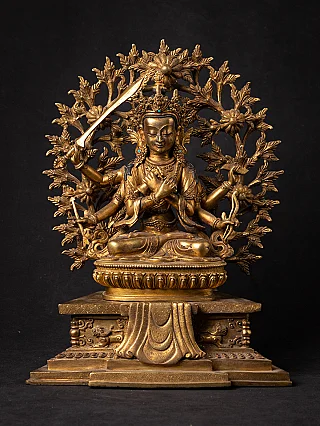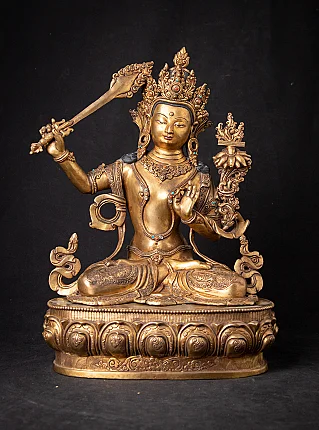Manjushri
Author : Peter Vredeveld

Manjushri is one of the most important iconic figures in Mahayana Buddhism and is known as the Bodhisattva of Great Wisdom.
Manjushri is one of the most important iconic figures in Mahayana Buddhism and is known as the Bodhisattva of Great Wisdom. He is worshipped as the "Meditational Deity" in Esoteric Buddhism. The Sanskrit name of Manjushri is "Prajna," which means "gentle glory," "He who is noble and gentle," "soft glory," "Wondrous Auspiciousness," and so on. Buddhist monasteries' meditation halls, libraries, and study rooms often consist of images of Manjushri Bodhisattva. Manjushri is a famous Bodhisattva respected greatly in Chinese, Esoteric, Tibetan Buddhism, etc.
"Manjushri is the Bodhisattva of wisdom and insight, penetrating into all things' fundamental emptiness, universal sameness, and true nature. Manjushri, whose name means 'noble, gentle one,' sees into the essence of each phenomenal event." – Zen Teacher Taigen Daniel Leighton.
Manjushri is represented as a male Bodhisattva with their right hand wielding a flaming sword, "Vajra Sword of Discriminating Light," that represents the sharpness of Prajna, and his left hand wielding a beautiful blue lotus flower in full bloom. The Vajra Sword of Discriminating Light or Wisdom is believed to cut through ignorance and entanglements of conceptual views. This sword also represents the light of transformation when the sword is in flames. The magnificent Lotus flower is believed to hold the Prajnaparamita Sutra (Great Wisdom Sutra ) and contains the essence of the great Wisdom of Lord Buddha.
Manjushri in Different Buddhism
Manjushri is identified as the oldest and most significant Bodhisattva in Mahayana Buddhism literature. Early Mahayana texts called "Prajnaparamita Sutra" referred to Manjushri as the embodiment of transcendent wisdom. Vimala, a pure land assigned to him by Lotus Sutra, is considered one of the two best pure lands that existed in the past, present, and future. Manjushri is considered a fully enlightened Bodhisattva and is greatly respected and worshipped as a "Meditational Deity."
In Chinese Buddhism, Manjushri is respected as one of the Four Great Bodhisattvas and is paired with Bodhisattva Samantabhadra. The other three Great Bodhisattvas are Bodhisattva Avalokiteshvara, Bodhisattva Ksitigarbha, and Bodhisattva Samantabhadra. In Tibetan Buddhism, Manjushri is worshipped as the great trinity Bodhisattva with Avalokiteshvara and Vajrapani.
Manjushri in Different Countries

In China, Manjushri is popularly known as Wenshu. to beMany Chinese Buddhists monks believe Mount Wutai Shan in Shanxi Manjushri Bodhimanda (position of awakening) and is one of the Four Sacred Mountains of Buddhism in China. The other three Sacred Mountains are Mount Putuo ( Avalokiteshvara Bodhimanda ), Mount Emei ( Samantabhadra Bodhimanda ), and Mount Jiuhua ( Ksitigarbha Bodhimanda ). It is written in the Sutra that Lord Buddha, in Final Nirvana, predicted that Manjushri Bodhisattva would reside on Wutai Mountain in China and would start teaching Dharma on Mount Wutai. Foguang Temple in Wutai Shan is one of the famous temples dedicated to Manjushri Bodhisattva.
In Tibetan Buddhism, Manjushri is believed to manifest many different tantric forms. Some famously manifested forms of Manjushri are Yamantaka, Guhya-Manjushri, Guhya-Manjuvajra, Manjuswari, and so on. Yamantaka is popular within the Gelug School of Tibetan Buddhism and is considered the wrathful manifestation of Manjushri. Jamgon Ju Mipham Gyatso is considered the human manifestation of Manjushri.
Manjushri holds a magnificent tale in Nepal. Kathmandu Valley was believed to be a lake and held a beautiful lotus flower in the middle of the lake, according to Swayambhu Purana. It is said that Manjushri cut the gorge at the Chovar and allowed the lake to drain. The lotus flower was believed to reside on the top of a mountain, and the mountain became Swayambhunath Stupa, and the valley became habitable.
Share this page























